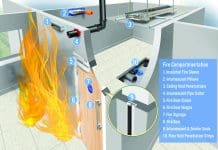An effective sprinkler system can reduce a multitude of costs from fire and here, Steve Mills, BAFSA Fire & Service Co-ordinator provides the evidence.
Since the very first occasion that mankind used fire to cook and keep himself warm the phenomena of fire has been the proverbial ‘double edged sword’. Humankind has been able to harness its power to amazing creative effect but has also felt the destructive force and human tragedy that fire has the potential to unleash. To know and feel that destructive element is perhaps everyone’s worst nightmare.
It was in response to that fear, witnessed in some very dramatic and tragic fires, and of course the financial benefits of not losing all one’s possessions, that some were determined in seeking a way of automatically dousing fire with water. Pioneering work came to a head, if you will excuse the pun, with the development of the world’s first automatic fire sprinklers in the 19th century and, though one has to say that the basic premise has remained true, since that time the concept has been continually developed. This has been achieved through thorough testing and design development, mainly aimed at reducing the economic cost of fire. It has been in more recent years that the potential life safety benefits of sprinklers have been portrayed, but has all this work been effective?
There is an array of statistics, produced from a variety of sources to show how effective sprinklers (aka water based fire suppression systems) are, and these can be most useful in discovering the potential benefits sprinklers have in controlling fire.
For instance, a quick web search of ‘fire sprinkler facts’ gave the following result:
- 99% of fires were controlled by sprinklers alone;
- 60% of fires were controlled by the spray from no more than 4 sprinklers;
- In New Zealand, where all fires have had to be reported for over 100 years, records show that sprinklers have been effective in 99.7% of cases.1
One has to say that these kind of statistics are very powerful but there is also other information which is not so unequivocal. Some of these have been produced in research documents over recent years which, whilst upholding the benefits of sprinklers have shown a more ‘cautious’ endorsement.
In addition, the information released by the DCLG (Department for Communities and Local Government) in their latest 2011-2012 fire statistics, as gathered from fire and rescue service reporting show that:
In 2010-11 there were 408 fires with the outcome where sprinklers were present in the room of origin. 43 fires were in dwellings and 365 fires were in other buildings. Of these, 172 (42%) were extinguished/ contained/controlled, 29 (7%) did not contain/control the fire, and 207 (51%) were not known.
For the purposes of this article I will discount the other DCLG statistical information relating to sprinklers being on the same floor as the fire – not I feel an unreasonable premise – that for any suppression system to be effective, it has to be in the same room as the fire (room of origin).
As can be deduced from the above, it would appear that there are large differentials of how effective sprinklers actually are if we look at statistical evidence only, especially as many sprinkler activations are believed to go unrecorded. What is perhaps needed is a broader view of the facts.
Seeking practical experience
As one with a fire & rescue service background, I am keen to understand and investigate the practical outworking of how sprinkler systems operate in real fire situations and how best to gather this information, and what information is likely to be of use.
Thanks to a growing network of people who diligently record information where sprinkler activations occur, a broader picture is emerging of their usefulness in controlling fire in a wide variety of building types.
Since first collecting such information in 2010 two things have become clear:
1) In the incidents reported, sprinklers are shown to be extremely effective in controlling fire size;
2) The level of interest shown in sprinkler incidents each year is growing;
2011: 32 incidents reported
2012: 60 incidents reported
2013: 63 incidents reported.
Since the introduction to this country of fire sprinklers into the residential and domestic arena, there have been a number of recorded sprinkler ‘saves’ in the home environment. However, the majority of recorded incidents appear to occur in commercial and industrial premises and this may be for a variety of reasons possibly relating to insurance claims, resetting of systems being seen as more of a priority for large premises, or a reticence to call the fire and rescue services to a controlled fire situation.
My figures for the past two years show the following breakdown of premise types where sprinkler actuations have been notified.
2012 2013
Factories 25 23
Warehouses 5 3
Retail/Entertainment 16 11
Schools 2 6
Dom/Res 7 11
Hotel 2 2
PPS 2 3
Recycling 3
For the vast majority of these cases, the outcome has been very successful in terms of the low number of systems that were actually triggered and the amount of fire damage caused to the property concerned. The most notable ‘failures’ of sprinkler systems occur where the system has been turned off or decommissioned, and at least three commercial incidents have been recorded where this has happened and the building concerned has been totally lost.
Two fires: different outcomes
It is often said that one picture can paint a thousand words and one of the most interesting aspects of the appraisal of sprinkler effectiveness can occur when photographs of incidents turn up from time to time. These really help to put the amount of damage into perspective. For instance, it is widely believed that sprinklers are ineffective at controlling kitchen fires, especially those involving burning oil or fat products.
It is generally understood that up to 60% of all household fires occur in the kitchen or are cooking related, so can sprinklers make a difference? Many of the ‘domestic’ incidents related to me seem to involve such fires and it is surprising to see how effective sprinklers are in such circumstances.
Below are two fire outcomes, the first following a cooker fire in a HMO in Birmingham.
The fire was intense enough to strip the plaster from the walls and incinerate most of the contents of the room. Fortunately no one was hurt but the roof was lost and several other tenants in the building had to be re-homed. The cost of repairs ran into several thousands of pounds and took several months to undertake, during which time all revenue from tenants was lost.
The second fire occurred in Brighton and this too involved a fat pan. The outcome is completely different, and the contrast stark.
As the fire became hot enough, a single ceiling mounted sprinkler head nearest to the cooker activated (this is normally at about 70ºC) and prevented the fire from taking hold. The occupant, a person known to be vulnerable from fire, was able to stay in her flat following the clean-up operations.
It is at this point worth mentioning that the fire service advice is never to throw water onto a fat pan fire as this is extremely dangerous and will cause the fire to dramatically flare up with potentially life-threatening consequences. This advice remains sound. Never throw water on to a fat pan or try to move a flaming pan of oil. While it is true that sprinklers do apply water to the fire, the way they do it, in small droplet form, allows heat to be far more rapidly absorbed and this aids suppression of the fire.
How do sprinklers suppress fire?
Fire spreads by conduction through solid matter, radiation and convection through the gaseous products of combustion. It is a three dimensional effect meaning that a fire can get rapidly out of hand. Sprinklers have been shown to be very effective in controlling fire spread and this is borne out in my data and from fire testing.
Firstly the water from the sprinkler head(s) introduces cooling/wetting to the fire area. This helps to control all three types of fire spread.
Fire gases are rapidly cooled and this is effective in preventing ‘flashover’, where flame propagation in the room is uncontrolled and everything is consumed by fire.
In addition, as water from the sprinkler wets the items surrounding the fire, this makes it more difficult for radiation to set fire to nearby objects such as furniture.
There is also strong evidence to suggest that as the water droplets pass through the fire gases, a certain amount of ‘scrubbing’ takes place, reducing the toxicity of the products of combustion.
What is the conclusion?
Evidence from sprinklers activated in fires within the United Kingdom is beginning to match that from other countries, especially in the residential and domestic field where sprinkler systems have been in use for a much longer period.
While this article reflects just a snapshot of all the sprinkler activations that are occurring, it does contain a common thread to show that where a correctly designed, installed and maintained sprinkler system is activated by fire, the outcomes show reduced fire damage, increased resilience and reduced costs from fire, improved business continuity and less environmental damage.
I leave you to draw your own conclusions. ■
1 Fire Sprinkler Information and Discussion Forum
. . . . . . . . . . . . . . . . . . . . . . . . . . . . . . . . . . . . . . . . . . . . . . .
Steve Mills
Fire & Service Co-ordinator
BAFSA (British Automatic Fire Sprinkler Association)
Tel: 01353 659187






![[Video] Enhancing safety with fire doors: A case study of Marina Care Home](https://www.pbctoday.co.uk/news/wp-content/uploads/2025/06/maxresdefault-218x150.jpg)





![[VIDEO] Making DorTrak reports easy to read with Fireco Inspecting fire doors at Fireco, firedoor technology, 2023](https://www.pbctoday.co.uk/news/wp-content/uploads/2024/04/JPZ_2364-web-218x150.jpg)

